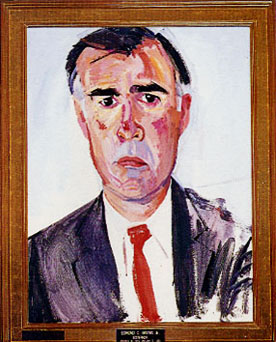-

Peter Burnett
1849–1851 -

John McDougal
1851–1852 -

John Bigler
1852–1856 -

J. Neely Johnson
1856–1858 -

John Weller
1858–1860 -

Milton Latham
1860–1860 -

John Downey
1860–1862 -

Leland Stanford
1862–1863 -

Frederick Low
1863–1867 -

Henry Haight
1867–1871 -

Newton Booth
1871–1875 -

Romualdo Pacheco
1875–1875 -

William Irwin
1875–1880 -

George Perkins
1880–1883 -

George Stoneman
1883–1887 -

Washington Bartlett
1887–1887 -

Robert Waterman
1887–1891 -

Henry Harrison Markham
1891–1895 -

James Budd
1895–1899 -

Henry Gage
1899–1903 -

George Pardee
1903–1907 -

James Gillett
1907–1911 -

Hiram Johnson
1911–1917 -

William Stephens
1917–1923 -

Friend Richardson
1923–1927 -

C.C. Young
1927–1931 -

James Rolph
1931–1934 -

Frank Merriam
1934–1939 -

Culbert Olson
1939–1943 -

Earl Warren
1943–1953 -

Goodwin Knight
1953–1959 -

Edmund G. "Pat" Brown
1959–1967 -

Ronald Reagan
1967–1975 -

Edmund G. "Jerry" Brown
1975–1983 -

George Deukmejian
1983–1991 -

Pete Wilson
1991–1999 -

Gray Davis
1999–2003 -

Arnold Schwarzenegger
2003–2011 -

Edmund G. "Jerry" Brown
2011–2019 -

Gavin Newsom
2019–Present

Edmund G. "Jerry" Brown
2011–2019
(Previous term: 1975–1983)
Significant Facts
Born: April 7, 1938 in San Francisco, California
Married: Anne Gust on June 18, 2005 in Oakland, CA
Political Party: Democrat
Family
Father: Edmund "Pat" Brown
Mother: Bernice Layne
Wife: Anne Gust
Children: None
Find out more about the time period and interests of Edmund G. "Jerry" Brown
Did You Know?
- At age four, he became the youngest person to climb Yosemite's legendary Ledge Trail
- He was a cheerleader at St. Ignatius High School
- He started two charter schools in Oakland – the Oakland School for the Arts and the Oakland Military Institute
 Biography
Biography
Edmund G. "Jerry" Brown, Jr., the son of former Governor Pat Brown (1959-1967), was born in San Francisco on April 7, 1938. He graduated with degrees in Latin and Greek from the University of California, Berkeley in 1961 and received a juris doctorate from Yale in 1964. His education also included studies at the Jesuit Seminary in Los Gatos, California.
Following law school, Brown worked as a law clerk to California Supreme Court Justice Mathew Tobriner, traveled and studied in Mexico and Latin America, then took up residence in Los Angeles, working for a law firm. In 1968, he helped qualify a slate of presidential delegates to oppose the re-nomination of President Lyndon Johnson. The following year, Brown was elected to the Los Angeles Community College Board of Trustees.
In 1970, Brown was elected California's Secretary of State, a position he held until his inauguration as Governor in 1975. As governor, he had strong ideas about state spending and refused to live in the new governor's mansion, renting a modest apartment instead, and nixing the governor's limousine in favor of a state-issued Plymouth. He focused on energy efficiency and alternative power sources, sponsored and signed the first labor laws in the United States to protect farm workers, and signed into law the California Conservation Corps (CCC) program. His appointments emphasized minorities and women, echoing the social awareness of his era.
After his two terms as governor, Brown unsuccessfully ran for United States Senator in 1982. He then travelled extensively, returned to his law practice in Los Angeles, and in 1989 became chairman of the state Democratic Party. He resigned that position in 1991, and unsuccessfully sought the 1992 Democratic Presidential nomination. In 1998, Brown was elected Mayor of Oakland, California. Brown was re-elected in 2002 and held the post until 2007.
Brown was elected Attorney General of California in 2006 and announced his candidacy for Governor in March, 2010. Since Brown's previous terms in office were not covered by term limit laws enacted in 1990, he was not barred from running for Governor again. Jerry Brown is the only governor to return to the office after serving years before.
 Budgets
Budgets
- 2011/2012
- Governor's Budget
- Governor's Revised Budget
- 2012/2013
- Governor's Budget
- Governor's Revised Budget
- 2013/2014
- Governor's Budget
- Governor's Revised Budget
- 2014/2015
- Governor's Budget
- Governor's Revised Budget
- 2015/2016
- Governor's Budget
- Governor's Revised Budget
- 2016/2017
- Governor's Budget
- Governor's Revised Budget
- 2017/2018
- Governor's Budget
- Governor's Revised Budget
- 2018/2019
- Governor's Budget
- Governor's Revised Budget
 Speeches
Speeches
- Inaugural Address delivered on January 3, 2011
- Inaugural Address delivered on January 5, 2015
- State of the State Address delivered on January 31, 2011
- State of the State Address delivered on January 18, 2012
- State of the State Address delivered on January 24, 2013
- State of the State Address delivered on January 22, 2014
- State of the State Address delivered on January 21, 2016
- State of the State Address delivered on January 24, 2017
- State of the State Address delivered on January 25, 2018
 Bibliography
Bibliography
Books and Articles
- Schaechtele. The Governors of California and their Portraits, California State Capitol Museum Volunteer Association, 1995
Websites
Copyright © 2019 California State Library, All Right Reserved






